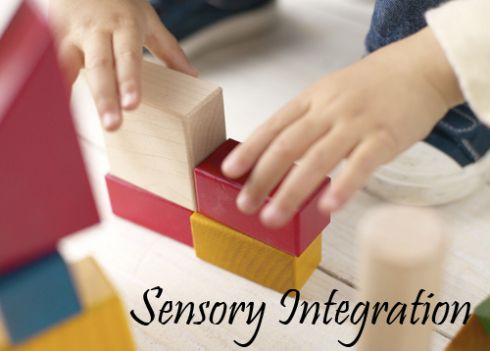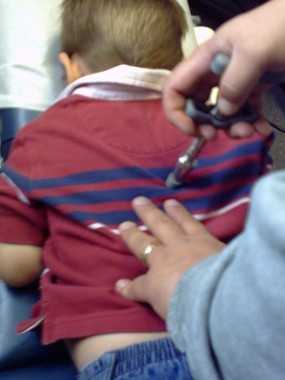Sensory Processing Disorder: Recognizing the Signs, and What Can Help

About the Author

Dr. Jeanne Sandheinrich, D.C.
Dr. Jeanne Sandheinrich, D.C. is co-founder and an esteemed chiropractor at First Step Family Wellness. As a St. Louis native, she has a deep connection to her community and is passionate about providing exceptional care to her clients.
Recognizing and Diagnosing Sensory Processing Disorder
Our senses are what guide us through everyday life. Keeping us in tune with ourselves and the rest of the world. Yet, occasionally our sense of taste, smell, touch, hearing or sight becomes misguided by something physical or environmental.
It could be anxiety that spawns from family life, work responsibilities, or the effects of depression. It could be seasonal allergies or irritation from the tag on your new shirt. Or you maybe a picky eater, find it difficult to focus with surrounding ambient sounds, and have pain in your hands from repetitive tasks.
While such things are usually temporary for many of us and easily treated, the STAR Institute has previously found that approximately 16% of children (ages 7 to 11 years old) have a unique disorder called Sensory Processing Disorder (SPD). It is unclear what percent of adults are diagnosed with SPD, considering that many times SPD is overlooked and misdiagnosed as ADD/ADHD, autism, Asperger’s, depression, or another mental disorder. This makes it important for individuals and parents to be able to recognize what everyday symptoms are associated with the disorder, and what steps may be taken to help them find greater sensory balance in everyday life.
What is Sensory Processing Disorder?
Sensory Processing Disorder (SPD) is a neurological problem that causes disruptions and over-stimulations in the sensory areas of your brain; which in turn impairs your ability to respond, process, and organize daily sensory information.

This not only includes the five senses you were taught throughout upper elementary school and middle school, but also the most significant elements of your sensory processing system – the vestibular and proprioceptive systems – that you most likely have never heard of if you’ve never studied anatomy at some point in your life. The vestibular sensory system is in your middle ear and is what balances how your sense of smell, taste, sight, hearing and touch interact with themselves and the space around you. Meanwhile, the proprioceptive system controls the reactions, sensations and motions of your joints and muscles that may become imbalanced or disoriented. In other words, it’s what controls each of your body parts and is your physical awareness.
What Causes Sensory Processing Disorder?
Studies have found that Sensory Processing Disorder can often develop when, if, and how a child has successfully reached primary developmental milestones. If the senses are underdeveloped, such as with infants in the first four-months of life, then what is called the Moro reflex may become activated. By definition the Moro reflex is losing partial or full control of your body – the same feeling you get when you have a shiver up your spine, or are startled by a person or unexpected sound.
If these milestones are not readily developed and practiced, then they remain under-developed throughout our lifetime; often increasing the likelihood of being more stressed, depressed, introverted, under-achieving, anxious, and unhappy on a daily or consistent basis.
In addition, other common factors have been found to also contribute to the 16% prevalence of SPD in children and adults. The physical and social environments that surround us have a direct effect on our growth and evolution as individuals, such as a heavily polluted city or a neglectful and hateful family life. It also includes the type of labor and stress-level of your child’s birth; such as natural, medicated, cesarean, and any correlating problems before, during or after. In addition to the elements of your DNA, the primitive nature retained from our ancestors, and spinal misalignments that affect your joints and range of motion can also cause Sensory Processing Disorder.
Red Flags of SPD to Remember
The evidence of your child having Sensory Processing Disorder is likely to be different from the signs another person with SPD has, however it is likely that – depending on the affected sense and area – all signs are severe across the spectrum. Not only is it possible for only one or all five of the senses to be over- or under-stimulated, signs may appear at different times in one’s lifetime.
Generally, here are the most common red flag symptoms that you should watch for:
- Touch: Social anxiety, poor concentration, poor academic grades, aversion to touching others or craves a need to be touched, overly-controlling, easily irritated, hates being dirty or messy, can’t sit still, uses mouth to explore objects, and poor dexterity.
- Smell: Excessive food or environmental allergies, often smells objects or other people, does not like new objects due to odd smells, and poor behavior or health around certain chemicals.
- Taste: Picky towards many foods, show signs of pica, and problems eating.
- Auditory: Becomes easily angry or irritated towards certain sounds, makes particular and repetitive sounds towards technological or other environmental noises, has issues following directions, hypersensitivity, consistently messes with ears and speaks loudly, little or no vocalization, and difficulty understanding speech.
- Visual: Poor hand-eye coordination, visual pain or discomfort, consistent headaches, problems reading by themselves or in-front of others, difficulties walking up or down stairs, etc.
- Vestibular: Dislikes certain physical or environmental movements, likes watching repetitive movements (such as fans), issues reading and writing in cursive, poor listening skills while active, poor balance, motion sickness, or consistent and violent head banging.
- Proprioception: Has a need for physical contact, dislikes having their head touched, sleep problems, inability to keep eyes closed for lengthy periods of time, sleepwalking, restlessness, need to be covered by heavy materials, dislike of team sports, poor math skills, extreme clumsiness, and so on.
Recommended SPD Treatments
When your vestibular sensory system is out of balance with one or more of your senses, it is directly linked to a physical imbalance or stress in your upper neck. Thus, if you are injured, sick, stiff or stressed your Moro reflex becomes activated and your nervous system goes in overdrive. If left untreated, this begins to reduce the support, stability and strength felt throughout the rest of your body. It is something you will easily recognize, due to the overall discomfort it brings, and will need to sway you towards effective at-home and chiropractic treatments.
Before taking matters into your own hands, it is best that you speak with your general physician and licensed chiropractor about your symptoms and the right treatment options for you or your child.
Generally, it is important that you practice a consistent stress-free lifestyle that keeps you mentally and physically active, to ensure that your sensory pathways remain strong and well-balanced. This includes stretching and exercising daily, particularly in the morning after you wake up to open and re-align your body from the day and night before. Many practice tai chi, yoga and/or meditation, take moderate outdoor walks or runs, body-strengthening exercises, hula-hooping, dance, and any other strong therapeutic movements. While also eating well, like reducing or eliminating sugar, artificial ingredients and caffeine. I know, the latter may seem impossible!
You will also want to schedule a session with your chiropractor, like Dr. Ryan and Dr. Jeanne Sandheinrich of First Step Family Wellness in Kirkwood, Missouri; who will be able to tell you which receptors (electrical impulses) in your cervical spine are being negatively affected, reducing your control and increasing your discomfort. Having regular chiropractic adjustments to fit your needs will effectively rebalance your seven senses and gradually improve your sense of control in your daily life.

How First Step Family Wellness Can Help
Since mid-2013, Dr. Ryan and Dr. Jeanne of First Step Family Wellness, have successfully treated individuals of all ages suffering from general pain and discomfort to disorders like Sensory Processing Disorder. If your main complaint is an over-abundance of allergies, consistent headaches or migraines, and neck or back pain; then Dr. Ryan uses his chiropractic skills to help your body heal and re-balance itself. Alternatively, if your child suffers from similar issues or has shown any of the symptoms discussed above, then Dr. Jeanne uses her expertise in chiropractic care and acupuncture techniques to balance their sensitive sensory pathways.
If you spot SPD symptoms in you or your child, come visit us at First Step Family Wellness in Kirkwood, MO today to start living a more balanced and content life.